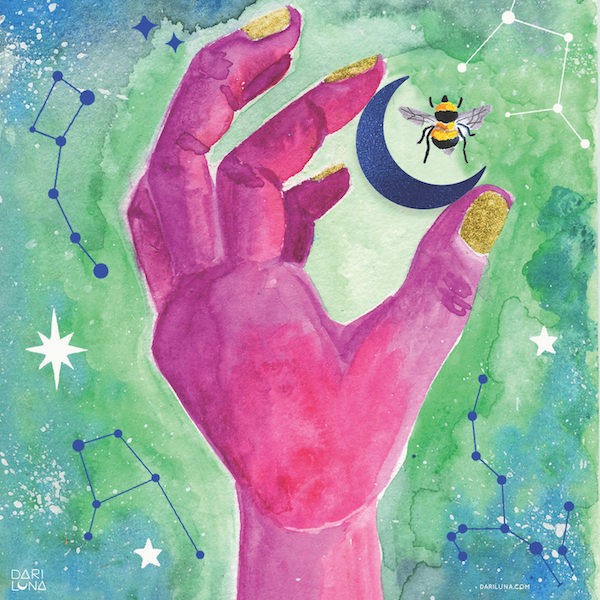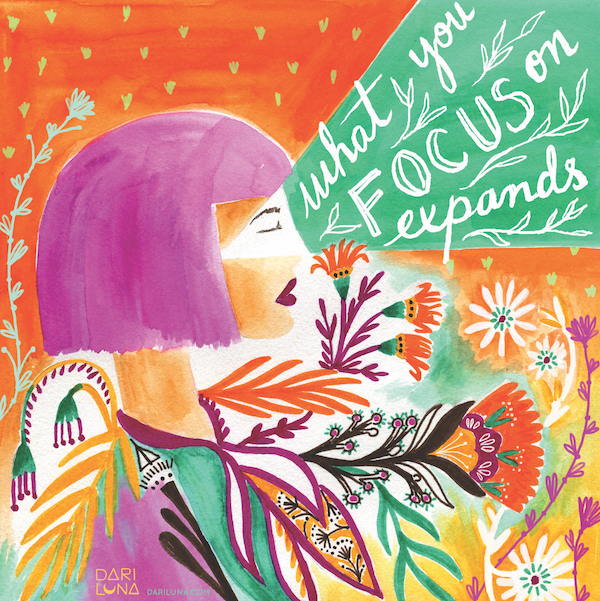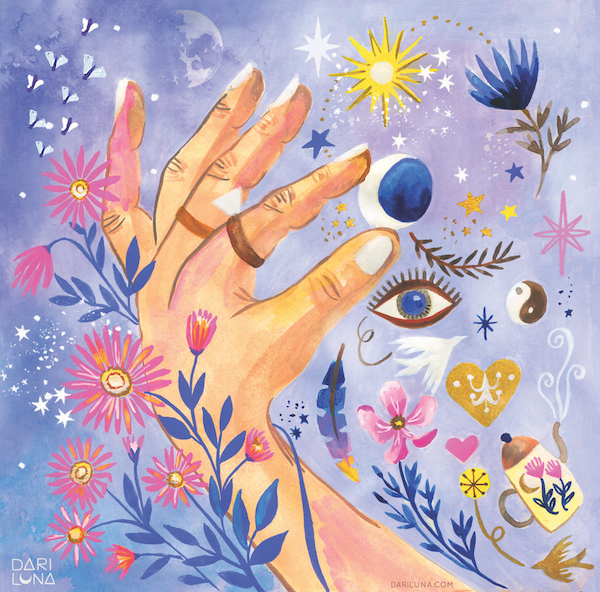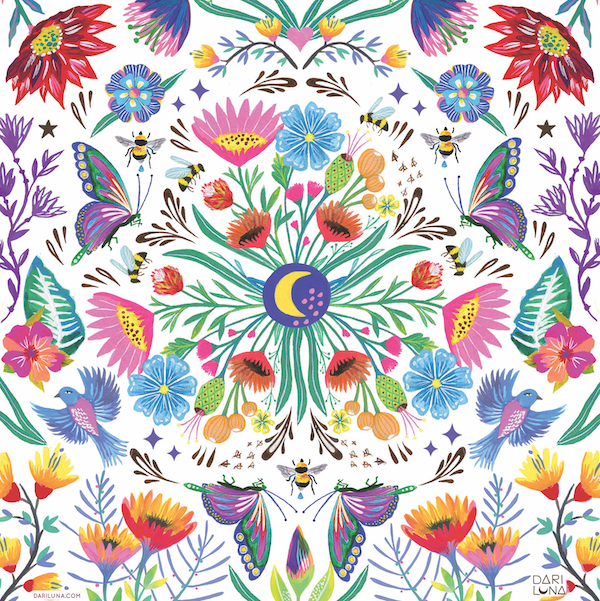A Roadmap for Creative Growth
Images by Dari Luna
Are you a victim, a vessel, or something else?
It’s almost midnight, the night before her dreaded monthly deadline.
Tania can’t manage to put more than three sentences together, even though she’s writing on her favorite topic. Her face is looking more and more anxious. She grabs her phone to scroll her defeat away.
Her phone beeps with the arrival of a new text: Are you up? I wanted to confirm that we are still on for tomorrow’s breakfast. I’m so excited to see you and catch up! It’s from Sara, Tania’s friend of many years. Sara is in town to put the final touches on a house she designed as a place to host events. It’s one of Sara’s many side projects.
To Tania, Sara’s creative process has always seemed effortless. Miserably comparing herself to her friend, Tania decides she won’t be able to overcome her creative failure and goes to bed.
Sound familiar? Everyone, at times, feels like Tania, in creativity, friendship, life, and work.
According to Dr. Michael Bernard Beckwith, there are four stages of consciousness that we navigate through in a nonlinear way throughout our entire lives. These stages define how we experience life. Moreover, they define our ability to consistently make manifest our ideas through the creative process.
For example, during Stage One, we feel as Tania did—as if the creative muse is outside of ourselves. We become full of excuses, we are more susceptible to distractions, and we start comparing ourselves to others. In this stage, we operate from a low vibration frequency of blame and shame.
A better understanding of ourselves through the four stages of consciousness empowers us to make changes, to bring our ideas to fruition, and to stop resisting doing the work that fulfills us and that matters to the world we live in. This improved understanding of ourselves can also help us transform into a more beneficial presence for others.
Understanding the link between creativity and conscious- ness is challenging, but I’ve seen the work pay off in my own life. That doesn’t mean I’m always, or even ever, in Stage 4.
The roadmap is still helpful as a reminder of the path toward alignment in life and art.
The most common instance is when I catch myself com- plaining or procrastinating inwardly or out loud. I visually delete the statement, acknowledge the unmet need that is creating that feeling, and make amendments, either with myself or others. This formula always releases me into a strong feeling of liberation and connects me back with the life force in me.
It’s completely natural to jump from one level to another, sometimes forward and other times backward. Our consciousness growth isn’t sequential. Eventually, we stay longer on one level than another, yet that can take time.

Stage One: I Live in Victim Town
This stage is about not being able to see beyond our situation. Little by little, we start waking up to the realization that where we put our attention determines what expands in our life
BELIEFS AT THIS STAGE
• Life happens to me.
• I depend on my circumstances and other people in order to create.
CHARACTERISTICS
• Lack of inspiration; a sense of being stuck.
• Belief that circumstances in your life are the cause of your inability to create.
• Feeling frustrated at loved ones (or strangers) because they don’t believe in you.
• You are in your own head; there are lots of voices having arguments.
• Feeling ashamed of not being as creative as others.
• A strong sense of self-doubt about your creative abilities.
• Consuming more than creating.
• The creative muse seems to be outside of yourself.
• Feeling a stronger pull to safety rather than to uncertainty.
• Priorities are unclear and out of focus.
YOU MIGHT HEAR YOURSELF SAYING OR THINKING
The problem is that I’m too _________________.
Why does this always happen to me?
If only I had _________ I would be able to _________.
HOW TO MOVE PAST THIS STAGE?
Give up blame and shame.
• Brain dumps (intentionally download all thoughts available at any given time from your brain to a piece of paper for the purpose of organizing and prioritizing what really matters while cleaning out and removing what no longer serves you) and journaling.
• Cultivate discipline.
• Be willing to do something you haven’t been willing to do before, but with accountability.
• Create spaces in your life to connect with your intuition, preferably in nature.
• Befriend resistance by doing affirmations and meditation.
• Practice mindfulness.
• Get organized; create a structure and a detailed plan for your vision.

Stage Two: I’m in the driver’s seat
This stage is about the magic of universal laws and witnessing how they work in your life. It’s that feeling of thinking about something you want, talking about it here and there, taking action towards that vision—and then all of a sudden, life rearranges itself for you. This stage can be addictive because you realize you have the power of creation.
BELIEFS AT THIS STAGE
• I happen to life.
• Creativity is a force I can tap into and get a tangible result.
CHARACTERISTICS
• Discipline and believing in your process are the means to manifest your ideas.
• You discover that the more you focus on what you want to create, the more that creation comes to life.
• Feeling proud of being an author of your creation.
• You own your work and get really mad at anyone who copies your ideas.
• A strong need to protect your time, space, energy, materials, and everything else needed for creation.
• You rely on your training and techniques.
• You use the creative process to feel in command and show your talents.
• Your personal value relies on the uniqueness of your ideas.
• You’re strict and conditional about what you take on.
• You create based on attaining the final goal rather than for the experience of transformation.
YOU MIGHT HEAR YOURSELF SAYING OR THINKING
I love attaining the goals I set for myself. Hard work really pays off.
You can create anything you set your mind to.
HOW TO MOVE PAST THIS STAGE?
Give up control and power.
• Practice creating for the sake of creating, without control of the outcome.
• Create immersed in nature and solitude.
• Let the creative process guide you instead of the other way around. (The creative process knows better than you.)
• Practice surrendering to uncertainty versus trying to control it. It’s not about inaction; it’s about taking action from that place of surrender.
• Control is rooted in fear. What is it that you’re afraid of? Write about it.

Stage Three: I’m a Vessel
This stage is about that feeling when you are co-creating with the universe and you feel as if you are not the one writing that book, playing that instrument, moving that brush. You physically are— yet it feels way beyond what you could have done on your own.
BELIEFS AT THIS STAGE
• Life happens through me.
• I am a vessel through which creativity expresses itself.
CHARACTERISTICS
• Ideas knock at your door and you choose which ones to say yes or no to, but you don’t impose your ego on them.
• You understand that the purpose of the creative process is to transform and expand you, not the other way around.
• It doesn’t feel like hard work; it feels like showing up and becoming available.
• You understand that ideas are not yours to own.
• You appreciate how the same idea manifests in unique ways through different people.
• You flow with ideas based on intuitive feelings, not exterior stimulus or recognition.
• You trust the creative flow no matter how it looks.
• An uncontrolled approach to the creative process always reveals itself in astounding and unimaginable outcomes.
• You have a mindset of co-creating with your ideas.
YOU MIGHT HEAR YOURSELF SAYING OR THINKING
It’s like an external force does all the work.
When I’m creating, time stops.
I would’ve never imagined that idea would take me here!
HOW DO YOU MOVE PAST THIS STAGE?
Give up ego and separation.
• Forgiving heals the separation from your inner light.
• Reprogramming memories. (See sidebar below.)
• Mindfulness.
• Surrendering.
A Method for Reprogramming Memories
1. Set intention and create and uninterrupted space.
2. Start with a five-minute meditation.
3. Visualize a memory. For example, the moment my teacher insulted me in class many years ago.
4. Imagine you are throwing gold paint to the movie screen of this traumatic memory until it covers it completely.
5. Recreate this same memory with a new movie that is congruent with your healing process and congruent with love and forgiveness. For example: The time the teacher talked to me with love and care.
6. Play the new memory in your mind over and over again.

Stage Four: I Am One With Creation
This stage describes the consciousness of an enlightened being. We can compare it to those moments when we see our newborn baby for the first time and we feel that time stops. We feel so present that everything is one with us. We can dare to say that Jesus Christ and Buddha live in this state of creation.
BELIEFS AT THIS STAGE
• Life happens as me.
• I am one with creation.
CHARACTERISTICS
• I am the creating force; we are one.
• I am one with universal intelligence.
• Creativity isn’t outside of me; it’s not something I can affect or that can flow through me. Creativity is me.
I invite you to be kind to yourself as you navigate throughout the four stages. We all have access to the creative process and its power. Growth requires patience and self-compassion. Transformation happens over time by focusing on the little things with consistency. As you realize your current stage, be thankful for what this present moment has gifted you and stay away from judgmental thoughts. Apply mindfulness by just observing yourself, your circumstances, the people around you, and everything else that crosses your mind with compassion, take inspired action, and trust that the universe is always for you—never against you—regardless of the circumstances.

